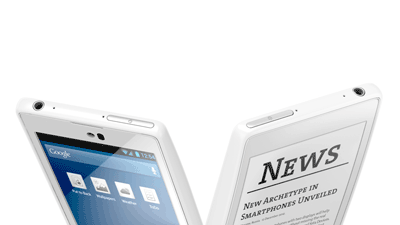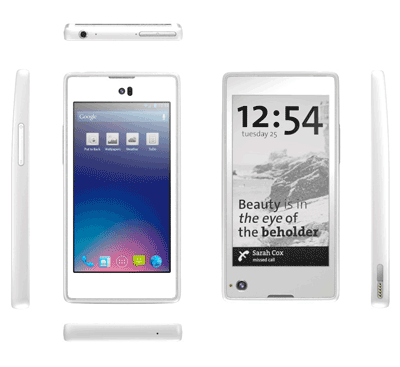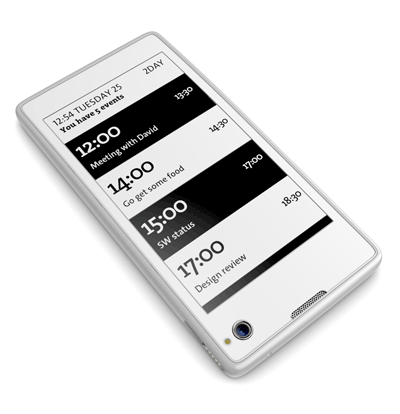Russians prepare to bring first-of-its-kind dual-screen smartphone to market
Phone features LCD display on one side, e-ink screen on the other
Well, here’s something you don’t see every day: A Moscow, Russia-based mobile phone company is getting ready to reveal a new type of phone that, if successful, could usher in a whole new generation of smartphones.
Their novel concept: a two-sided smartphone that features a full-color LCD screen on one side, and an electronic-paper display on the other.

The YotaPhone, by Yota Devices, features an LCD screen on one side, and electronic-paper display on the other.
The company, Yota Devices, believes that the two-screen device — aptly referred to as “YotaPhone” — will allow users to enjoy the seamless streaming of information as well as longer battery life.
Yota will officially show the new phone at the Mobile World congress in Barcelona in February 2013.
Background behind the story
To date, the company has been working on YotaPhone for more than two years, with the first model being shown to then Russian President Dmitry Medvedev in September 2010 at a meeting on the country’s modernization program.
The company has since filed a number of patents, copyrights, and design rights associated with YotaPhone.
The phone itself comes with many of the standard features that the average smartphone user is already accustomed to, including a dual-core Snapdragon S4 processor, 2-Gbyte or RAM, a 720p 4.3-in. display, 12-Mpixel camera, 2,100-mAh battery, LTE, and NFC, all of which is supported by Android 4.2 Jelly Bean.
So, if everything else is so . . . normal, why add an electronic-paper display? Convenience, really.

The addition of an electronic-paper display to a modern-day smartphone allows for convenient, always-on functionality.
Having an e-ink display allows users to enjoy the continuous streaming of data in real time, from Twitter feeds to chat sessions to stock-market tickers, all without having to wake up one’s phone from sleep mode or otherwise drain the battery.
“Today if you want to check your e-mail, calendar, or social media page, you have to pick up your phone, turn it on, open the application, and only then can you receive the information,” Yota CEO Vladislav Martynov explained. “With YotaPhone, this information will appear on the electronic paper display effortlessly, continuously and updated in real time.”
The extra screen also gives users the ability to display pictures, screen grabs of maps, or display ticket information without ever having to touch the phone. The image itself even remains in place when the phone runs out of battery.

The electronic-paper screen continues to display even when the YotaPhone runs out of battery.
“This will be the first time that people will be able to personalize the information they want to receive on their phones in an effortless way,” Martynov adds. “You tell YotaPhone what information you want and when you want it. It becomes your personal assistant, reminding you of what’s important to you.”
Some minor sticking points
While there’s a lot of potential with a product like this, some odd decisions are being made. For one, there’s a curved display on just one side of the phone, using a first-of-its-kind rounded glass from Corning. While the market clearly craves thinner phones, this bulging design is purposeful as it is meant to encourage the user to always point the e-ink screen up when the phone is set down.
Smart, yes, but it does make the phone a bit more cumbersome than need be.
Also, the e-ink screen is not fully touch sensitive; rather, it’s only partially so. Additionally, a color version of the screen is unlikely until a few generations of the product have come out (or until Apple or Google swoops in and updates the technology for its own line of product).
Outlook
Yota isn’t the first dual-screen smartphone to hit the market: dual-screen LCD display phones have been introduced to the Asia market before, though they haven’t fared well.
Companies have also introduced smartphones with partial e-ink displays in the past, while others have come up with slip-on covers that use the low-power screens. Never heard of them? Then you can probably guess how successful they were with their attempt at carving out a niche audience.
To set themselves up for success, Yota is taking a different approach than other companies when it formally introduces itself to the mobile market. You see, unlike its predecessors — which often license their ideas to more established manufacturers — Yota will produce its own design and bring it to market through contracts with global carriers. Production of the devices will take place in Asia by a tier-one supplier.
E-Ink Corp., meanwhile, has been working with Yota to develop the e-reader aspect of the phone, which should comfort those questioning whether the technology will be a knock-off of the real thing. The company has said that the YotaPhone will be the first to fully integrate its technology.
After the YotaPhone is introduced in February, the company’s goal is to have it hit shelves come the second half of 2013. ■
Story via: yotaphone.com
Advertisement
Learn more about Electronic Products Magazine






